50 Card Games to Curb Boredom
By Neal Taparia - Last updated: 12/03/2024
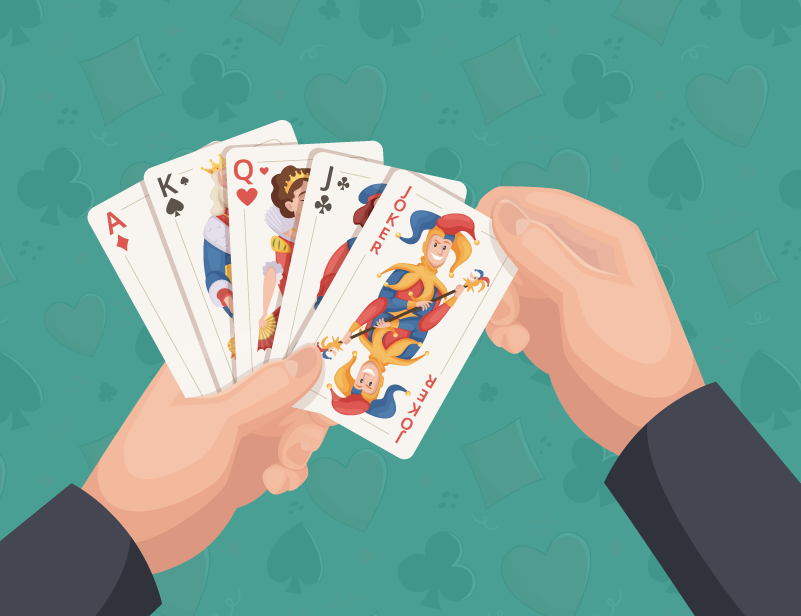
A couple of decks of cards may not seem like much, but they can provide hours of fun. These popular card games include Solitaire variants, melding, family, trick-taking, gambling, matching, and shedding. In this post, we break down the types of games, the number of cards needed, and how to play them.
Table of Contents
- Solitaire Variant Card Games
- Melding Card Games
- Family Card Games
- Trick-Taking Card Games
- Gambling Card Games
- Matching Card Games
- Shedding Card Games
Solitaire Variant Card Games
These games are single-player variations of Classic Solitaire, with a focus on sorting all the cards into sequences to win or pairing them with other cards. These games can be played online at Solitaired or with a regular deck of cards. You can also play them against people, competing by playing simultaneously but with different decks.
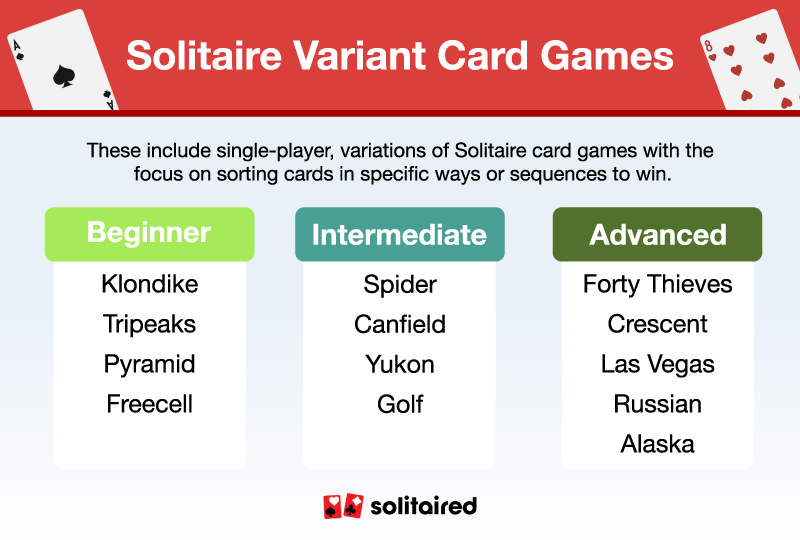
1. Klondike
Number of players: 1 player
Deck: A standard 52-card deck
Objective: To win the game, you need to arrange all cards into four foundation piles based on the suit and ascending in order from ace to king.
Every version of Solitaire is based on this classic gameplay. Some cards are facedown while others are in the stockpile, so you simply build columns of cards in a tableau and move them to the appropriate foundation pile. The columns in the tableau must descend in order and alternate color, while the foundation piles are separated by suit and ascend from ace to king. You can play Klondike Solitaire here.
2. TriPeaks
Number of players: 1
Deck: A standard 52-card deck
Objective: Clear the tableau into a waste pile by pairing cards one rank higher or lower than the waste pile card.
Try to clear the three peaks into the waste pile, not individual foundation piles, by pairing the waste pile card with a card one rank higher or lower in the tableau. The paired card then becomes the new waste pile card. In this game, the suit and color of the cards don’t matter, only the rank, and you can only pair available cards, meaning cards that are not overlapped by other cards. You can play Tripeaks Solitaire here.
3. Pyramid
Number of players: 1
Deck: A standard 52-card deck
Objective: Remove all cards from the tableau by pairing them to add to 13.
Like TriPeaks, you can only use cards that are not overlapping other cards, but you do have a stockpile to pull from. You’ll put all pairs into a waste pile until all the other cards are cleared. You can play Pyramid Solitaire here.
4. Freecell
Number of players: 1
Deck: A standard 52-card deck
Objective: The goal is to move all of your cards to the foundation piles from ace to king.
This is an easier version of Klondike, as all the cards are dealt face up. You can see the cards you’re working with and make moves as you see fit. There are four free “cells” where you can place any card so that you can reveal new cards to play. You can play Freecell Solitaire here.
5. Spider
Number of players: 1
Deck: Two standard 52-card decks
Objective: You organize the cards from king to ace and by suit in the tableau, and then you move them into their foundation piles.
You can choose between a single suit, two suits, or four suits in gameplay. Single suit is the easiest and four suits is the most difficult. You can play Spider Solitaire here.
6. Canfield
Number of players: 1
Deck: A standard 52-card deck
Objective: Clear the cards from the tableau, ascending in order and separated by suit.
Canfield begins with a base foundation card, and you build foundation piles in ascending order, meaning the first card might not start with an ace. For example, if the base card is the six of hearts, you start at the six of hearts and continue to the five of hearts. You’ll do the same for the other piles. You can play Canfield Solitaire here.
7. Yukon
Number of players: 1
Deck: A standard 52-card deck
Objective: You group cards together from ace to king into four foundation piles by suit.
There’s no stockpile in this game, and you arrange some of the cards face up. You begin with seven tableau piles. There’s one card in the first pile, two in the second, and so on until you have seven piles. You flip up the top card and then each pile gets an additional four face-up cards. You can play Yukon Solitaire here.
8. Golf
Number of players: 1
Deck: A standard 52-card deck
Objective: The goal is to clear the tableau in the least amount of moves possible.
There are seven columns with five cards facing up in each column that make up the tableau. You want to pair the top card from the waste pile with one from the tableau that is one rank higher or lower to play. You can play Golf Solitaire here.
9. Forty Thieves
Number of players: 1 player
Deck: Two standard 52-card decks
Objective: The goal is to build eight foundation piles from ace to king.
There are ten tableau columns with four rows and the remaining cards in a stockpile. Cards are face up in the tableau and aces are the only cards that can start in foundation piles right off the bat. The main difference from Klondike Solitaire is that you can’t move groups of sequenced cards in the tableau which makes this game difficult. You can play Forty Thieves Solitaire here.
10. Crescent
Number of players: 1
Deck: Two standard 52-card decks
Objective: Move the cards in the tableau to the eight foundation piles.
Four aces are put in the first four foundation piles, and four kings are in the other four foundation piles. You start placing cards in those piles in ascending (aces foundation piles) and descending order (kings foundation piles), until you clear the tableau. You can play Crescent Solitaire here.
11. Las Vegas
Number of players: 1
Deck: A standard 52-card deck
Objective: You want to earn more “money” than what you wagered.
In this game, you play with virtual tokens that don’t represent real-world currency. You earn “money” by moving the cards to the foundation piles. You can only go through the stockpile once, which makes it more difficult than the traditional Klondike Solitaire. You can play Las Vegas Solitaire here.
12. Russian
Number of players: 1
Deck: A standard 52-card deck
Objective: You want to move all cards to the foundation piles from ace to king by suit without a stockpile.
In this game, the cards are sequenced in the tableau by suit instead of the opposite color. There’s also no waste pile or stockpile, which makes it challenging as you rely only on the tableau to move cards to the foundation piles. You can play Russian Solitaire here.
13. Alaska
Number of players: 1
Deck: A standard 52-card deck
Objective: Move all cards to the four foundation piles from ace to king by suit.
You build your cards in ascending order by suit in the tableau like Russian Solitaire. Tableau cards are sequenced in ascending or descending order. You can move a group of cards no matter the order, so long as the top card of that group is one rank higher or lower and the same suit as the card it’s being placed on. You can play Alaska Solitaire here.
Melding Card Games
Melding card games are games where you meld cards, or make combinations with them. A meld can be different for each game, such as runs or sets of rank like in rummy games, depending on the rules. So we’ll go into the details of each game below.
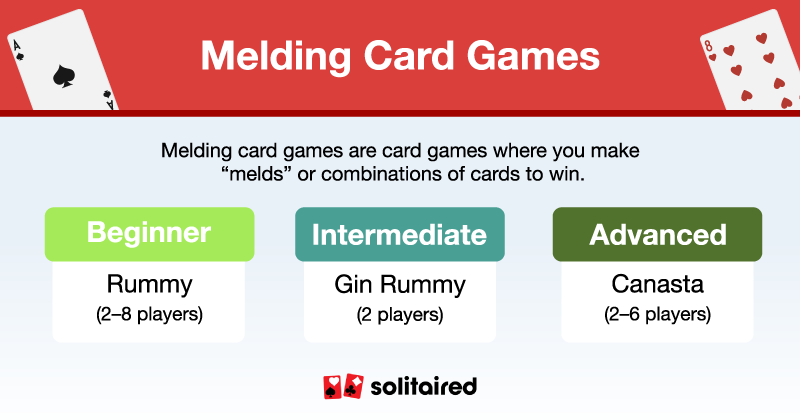
14. Rummy
Number of players: 2–6
Deck: A standard 52-card deck
Objective: The winner is the one who scores the agreed-upon amount of points.
You meld your cards into groups of at least three of the same rank or at least three in a run of the same suit (like the two, three, and four of clubs) over several rounds. You can add individual cards from your hand to existing melds on the table to maximize your points. Your score is based on points calculated from the value of your melds subtracted from the cards left in your hand.
15. Gin Rummy
Number of players: 2–4
Deck: A standard 52-card deck
Objective: Try to form melds reaching 100 points and have the least amount of unmatched cards, also called deadwood.
This game is like Rummy, but you don’t lay your cards out. You keep them in your hand instead. Because no melds are revealed, you can’t add cards to existing melds on the table. Instead, you draw a card from the deck or discard pile and then discard a card to make your hand as best as it can be. To end the game, you have to have less than 10 deadwood points or you have a gin, which means all your cards are melded.
16. Canasta
Number of players: Typically played with 4 in pairs
Deck: Two standard 52-card decks plus four jokers for 108 cards
Objective: The first one to 5,000 points is the winner.
You draw and discard cards as you try to make melds. Melds have points associated with them. You can draw from the deck or discard pile under certain situations. You can score points by making melds with three or more cards so you can make canastas, which are seven or more cards of the same rank.
Family Card Games
If you have a big family that needs entertainment, multi-player card games are a great way to have fun and engage everyone at the table!
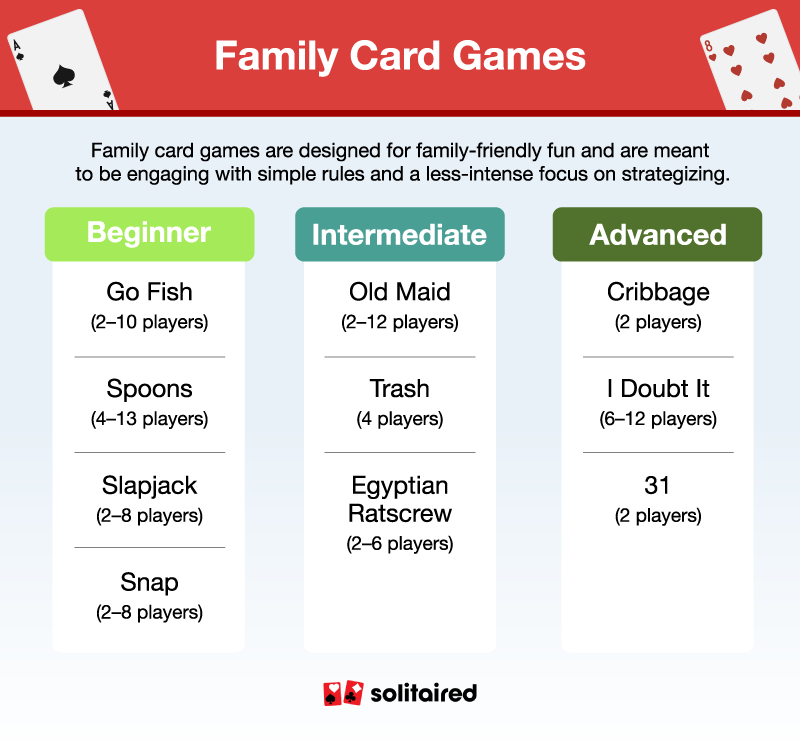
17. Go Fish
Number of players: 2–10
Deck: A standard 52-card deck
Objective: Win the most four-of-a-kind cards.
The point of the game is to make and match as many quartets by rank as possible, using your hand of cards, drawing from the stockpile, and asking opponents if they have a certain card. If they don’t have the card you’re asking for, they’ll say “Go fish,” and you’ll pull from the stockpile. You continue to play until there’s a winner.
18. Spoons
Number of players: 4–13
Deck: A standard 52-card deck and one less spoon than the number of players.
Objective: Discreetly take a spoon when you collect four of a kind (same rank) or avoid being the last to grab a spoon when someone else makes a match.
You place spoons in the center of the table, making sure there is one less than the total amount of players, and the players are dealt four cards. Players can pass cards around the table only looking at one card at a time to get four of a kind. Once you get a four-of-a-kind, you grab a spoon and then the rest of the players try to grab a spoon. If you don’t grab a spoon, you get the letter S, and once you spell SPOONS, you’re out.
19. Slapjack
Number of players: 2–8
Deck: A standard 52-card deck
Objective: Win all 52 cards at the end.
Deal cards evenly to each player keeping them facedown in a stack. You each flip a card in the middle of the table until a jack appears. The first player to slap the jack takes the center pile of cards, and you keep going until someone wins the game by taking all the cards.
20. Snap
Number of players: 2–8
Deck: A standard 52-card deck
Objective: Collect all the cards.
You take turns flipping your top card into the face-up pile without looking at your hands. If two face-up piles have the same card showing, the player that says “Snap” first will take both piles, adding them to their facedown cards. If you say it at the same time, both cards go into the snap pot. If you match the snap pot card, you yell “snap pot” and collect the whole pot.
21. Old Maid
Number of players: 2–12
Deck: A standard 52-card deck minus three queen cards
Objective: Play continues in a rotation until all cards are paired except for one, the queen card. Don’t be caught with the queen card, or old maid, at the end.
Players use the cards in their hands to make pairs and lay them down. After the dealer offers their hand of cards to the player on their left for them to draw a card, facedown, play continues in a rotation until all cards are paired except for one, the queen card. The person left with the old maid, or queen card, loses.
22. Trash
Number of players: 4
Deck: A standard 52-card deck
Objective: Be the first to arrange your cards in order from ace to ten.
Each player creates two rows of five cards that are facedown, and each player takes turns drawing from the center stockpile. There are spots arranged from ace to ten, and players place the cards in the correct spot, either playing or trashing the facedown card. The game keeps going until a player completes their sequence, stating “Trash” to prompt the final round for the other players to complete their sets.
23. Egyptian Ratscrew
Number of players: 2–6
Deck: A standard 52-card deck
Objective: Be the player to win all the cards.
Players flip a card from their facedown pile one at a time into the middle. If an ace or face card is played, the next player has to play an ace or face card and is given a certain number of chances based on the type of face card or ace that was played into the middle. If the player doesn’t play either, the whole stack goes to the first player who played the face or ace card. Alternatively, you can win the pile by slapping the pile of cards when you meet certain conditions, such as two cards of the same rank played consecutively or like a sandwich with a different card played in between them.
24. Cribbage
Number of players: Commonly played with 2 players
Deck: A standard 52-card deck and a cribbage board
Objective: Win by being the first player to score 121 points through combinations of cards earning you points.
You receive a hand of seven cards and give two cards to the crib, which is a separate hand that belongs to the dealer. With the starter card flipped face up, players take turns adding cards and card values until they reach 31. If a player cannot play a card without going over 31, they call, “Go.” You get points by playing the last cards, creating groups of the same rank, and making combinations, as well as having cards that add up to 15. Every hand is scored, and the dealer gets to score extra points with the crib. All points get pegged on the peg board. You can play Cribbage here and read our guide about Cribbage rules and strategies.
25. I Doubt It
Number of players: 6–12
Deck: A standard 52-card deck
Objective: Whoever gets rid of all of the cards wins the game.
You place cards facedown on the table and announce the number and rank you’re laying down, taking turns moving up the suit ladder from aces to kings. Lying is allowed in this game, but other players can call them out saying “I doubt it” if they think someone is lying. If you’re lying and get caught, you have to take all the cards. If you were telling the truth, the doubter has to take all the cards.
26. 31
Number of players: 2
Deck: A standard 52-card deck
Objective: Try to get your hand to add up to 31 of the same suit by the end of the round so you’re the last one standing.
Each player gets three cards facedown with the top card face up. You are also dealt three cards face up for a “widow,” so you either take a card from the draw or discard pile and then discard one card. The point of the game is to get your hand to add up to 31 of the same suit.
Trick-Taking Card Games
Trick-taking games can be played with family and friends, and they involve players winning tricks by playing high cards or other rules.
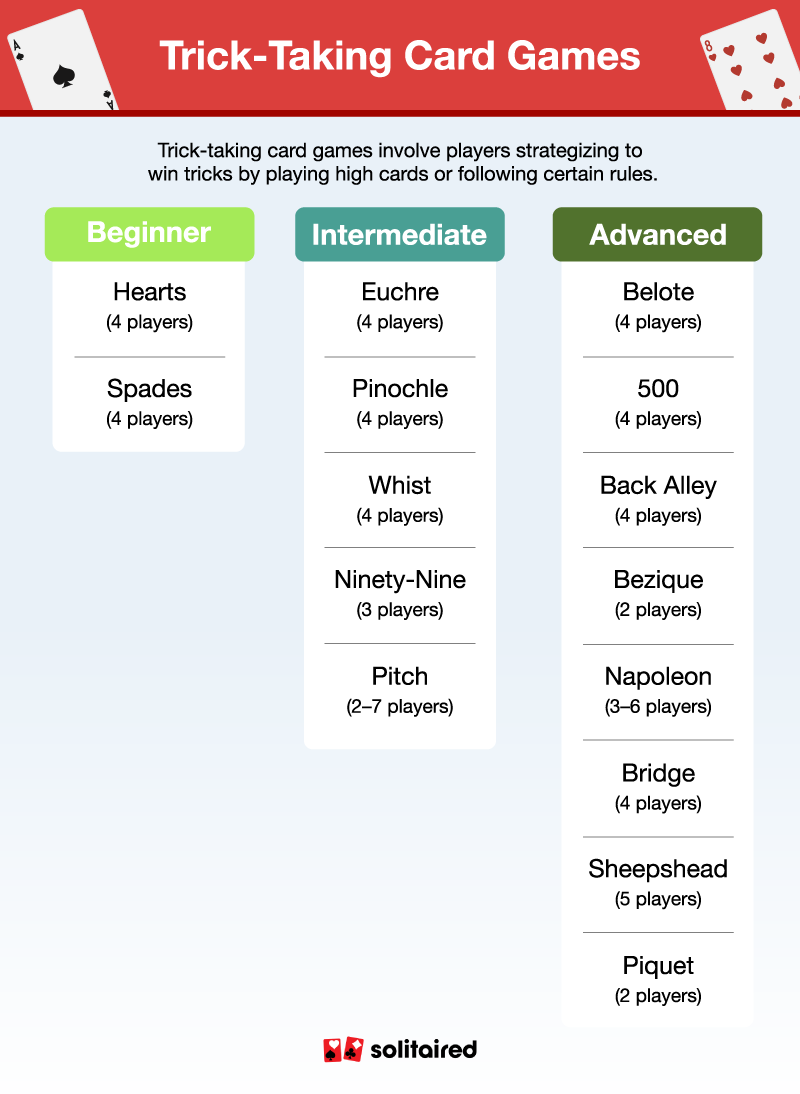
27. Hearts
Number of players: 4
Deck: A standard 52-card deck
Objective: Score the least amount of points by the time someone reaches 100.
You want to avoid getting points in this game—hearts are 1 point and the queen of spades is 13 points. You try to follow suit, getting rid of the high-value cards like hearts and the queen of spades. Within the tricks, the highest card of the suit led by the first person wins that trick and then leads the next trick. You can play Hearts here.
28. Spades
Number of players: 4 players usually play in teams of two
Deck: A standard 52-card deck
Objective: Teams or individual players predict the number of tricks they’ll win and try to make the correct predictions to score points and win.
Each player bids on how many tricks they think they will win. Spades are the trump cards, so they will trump every suit when played in a trick. Just like Hearts, the players have to follow suit based on what was led and the winner of the trick (highest rank of the suit led or the highest trump) leads the next. You can play Spades here.
29. Euchre
Number of players: 4 players in teams of two
Deck: A 24-card deck, removing two through eight from a standard deck of cards
Objective: Get points by winning tricks each hand, and the first team to 10 wins.
Each round, players choose trump which means the jack card of that suit is the highest ranking card. The other jack of the same color becomes the second highest rank. You must follow the suit that led if you have it, but can play trump or off-suit cards if you can’t follow suit. Players win a trick if one of them plays the highest ranking card of the lead suit or if they played the highest trump card, and you can try it out by playing Euchre here. Learn in-depth Euchre rules by reading our guide.
30. Pinochle
Number of players: Usually played as doubles with 4 people
Deck: Two standard 52-card decks with aces to nines removed for a total of 48 cards
Objective: You try to score 1,000 points by trick-taking and creating melds.
The game begins with a player leading, and they can only lead if they win the previous round. If a trump card begins, it can beat other cards, meaning you’d have to have a higher trump card to beat it. If a regular card starts the round, you can win that hand by playing a higher card of the same type or any trump card.
31. Whist
Number of players: 4 players in teams of two
Deck: A standard 52-card deck
Objective: You try to win the majority of tricks based on you and your partner's hand.
Everyone is dealt cards, with the final card going into the middle to set the trump card, which is added to the dealer’s hand. Each player plays a card to the middle with tricks winning you and your partner points. You try to follow suit, and if that’s impossible, you just play any card. Trump cards or the highest rank of the suit that led wins the trick.
32. Ninety-Nine
Number of players: 3
Deck: A standard 52-card deck
Objective: Avoid being the player to push the value of the card pile over 99.
The game begins at zero, and each player plays a card into the center that adds to the total. You have to play a card that keeps the total below 99 or else you’ll lose that round. If you do cause the total to break 99, then you lose the game.
33. Pitch
Number of players: 2–7
Deck: A standard 52-card deck
Objective: The first player who reaches seven points wins.
An American version of the English game Blind All Fours, this game has many variations, but if trump leads, the players must follow trump suit. But, if trump is not led, players can play any card and don’t have to follow suit. Bid on the points you anticipate winning in that hand, with the highest bidder choosing the trump suit.
34. Belote
Number of players: 4, playing in teams of two
Deck: A 32-card deck with only the seven through ace of each suit
Objective: Win 500 points.
A French card game that mixes trick-taking and melds, the card ranks affect point values, and the ranks can change based on trump. Although you first make declarations about the card combinations (melds) you can create, you only get to score your combinations if you win the hand by taking tricks. The game relies on strategy, and you do your best to score points against the opposing team.
35. 500
Number of players: 4 players in teams of two
Deck: A standard 52-card deck with one joker and the removal of all cards under the rank of five except for two red fours, making it a 43-card deck, depending on the number of players.
Objective: Be the first to reach 500 points by winning tricks with valuable cards.
The cards are not ranked like traditional card games. Instead, jokers are the highest, then jack card of the trump suit, and then the jack of the same color. A special scorecard helps you tabulate points, which are based on card values and bids. You follow suit of what’s led, but you can play any other card if you can’t follow suit.
36. Back Alley
Number of players: 4
Deck: A standard 52-card deck plus two jokers
Objective: Teams place bids on how many tricks they anticipate winning and try to win the most amount of points.
Everyone follows suit and players win tricks by playing the highest card or trump. However, the high joker forces everyone to play their highest trump card, while the low joker forces players to play a trump card. The score is kept based on the tricks you won and the tricks you bid for.
37. Bezique
Number of players: 2
Deck: Two standard 52-card decks with aces through sevens removed
Objective: You want to score as many points as you can by melding card combinations and winning tricks.
The ace is ranked 10, the king is worth 9, the queen is ranked 8, and so on. The highest card played in the lead suit will win that trick and can then make a meld, which is worth certain points based on card combinations. You play melded cards in tricks like it’s part of your hand, but they cannot be played when the stockpile is empty.
38. Napoleon
Number of players: 3–6 players
Deck: A standard 52-card deck
Objective: You want to either win more tricks than the highest bidder or be the highest bidder.
In this game, the players who bid the highest choose trump. If you can’t follow suit, play a trump card or discard a card. Whoever wins the trick leads the next one. Should you be the lucky bidder who wins the number of tricks they bid, you earn chips, which determine the score.
39. Bridge
Number of players: 4 players in teams of two
Deck: A standard 52-card deck
Objective: The object is to score points by winning the correct number of tricks you said you’d win.
Popular in America and throughout Europe, each player gets dealt 13 cards, and players bid on their turns to guess the number of tricks their team can get. The highest bidder determines the trump suit for the game, and the goal is to play one card each trying to follow the suit of the lead card—if that’s impossible, then you just play any card. Trump cards or the highest card for the starting suit wins the round. The goal is to get the same amount of tricks that you bid for.
40. Sheepshead
Number of players: 5
Deck: A 32-card deck with only the sevens through ace from each suit
Objective: Win tricks that have valuable cards to score the most amount of points, trying to reach 61 points.
An American version of a popular German card game, cards are dealt to each player with tricks created by playing cards in the middle. In this game, the highest trump cards are the queens, then the jacks, and then the diamonds. Non-trump cards, called “fail cards,” rank from highest to lowest as ace, ten, king, nine, eight, and seven. If you can’t follow the suit then you should play a trump card, with the highest trump winning the trick.
41. Piquet
Number of players: 2
Deck: 32-card deck where sevens to aces are the only cards
Objective: Score more points than your opponent over multiple rounds of creating card combinations and winning tricks.
Players are dealt cards, with the non-dealer swapping up to five cards from the stockpile and the dealer swapping the same amount of cards left in the stockpile. Players then declare their combinations and can score points for those combos. Whoever has the most points wins that round.
Gambling Card Games
Gambling card games are a different kind of social game, where you compete with your fellow players by betting on the strength of your hand or bluffing about it. A lot of gambling games use cards and simple rules, so this section describes a few examples of gambling card games.
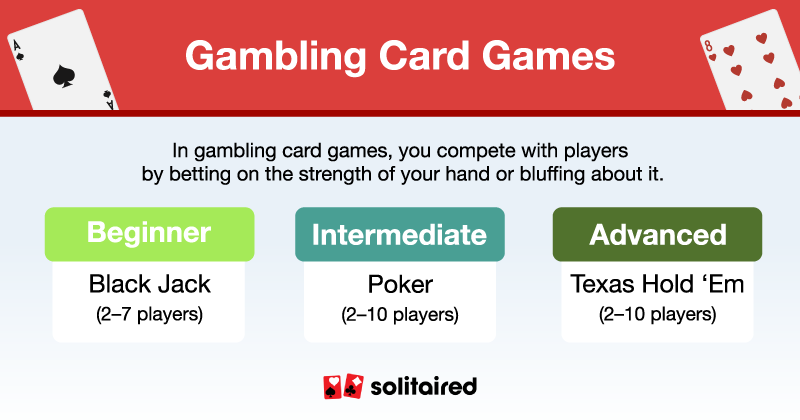
42. Black Jack
Number of players: 2–7
Deck: A standard 52-card deck
Objective: Get a hand value of 21 or as close to 21 without going over.
If you bust, which means going over 21, you lose the hand. You get to decide when you take another card, or a “hit,” which lets you keep your current hand. You also get to decide when to go for another hand, or “stand,” so you don’t take additional cards.
43. Poker
Number of players: 2–10
Deck: A standard 52-card deck
Objective: Win chips by forming the best five-card hand by betting or bluffing so opponents fold their cards.
Each player gets a hand of five cards, and each one bets the chips based on how good their hand is. Throughout the game, players can increase their bet, withdraw their hand, or match a bet. Players will then show their cards at the end, and whoever has the best hand wins the chips.
44. Texas Hold ‘Em
Number of players: 2–10
Deck: A standard 52-card deck
Objective: Win by forming the best five-card hand by betting or bluffing so opponents fold cards.
You begin with two cards first and go through betting rounds, forming your hand and eventually revealing your hand. Five community cards are dealt later in stages with the first stage of three cards known as “the flop,” an additional card known as “the fourth street” or the turn, and finally a card known as “the river” or “fifth street.”
Matching Card Games
In these matching games, the goal is to collect matching sets of cards. The trick is that you do it all by memory. Playing card games of any variety can be mentally stimulating, but matching card games give your memory and concentration a great mental workout.
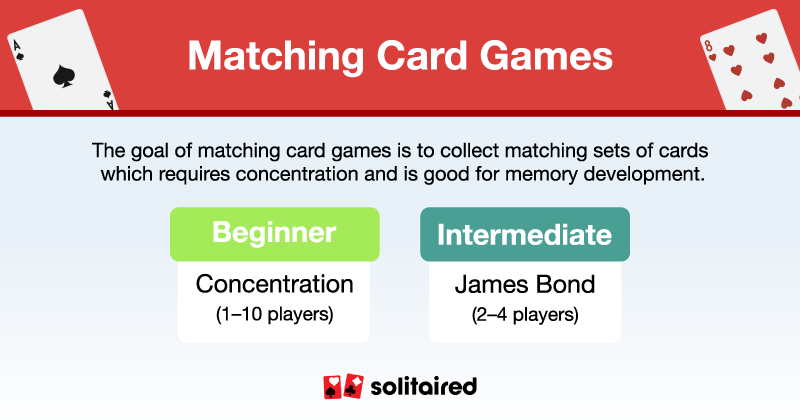
45. Concentration
Number of players: 1–10
Deck: A standard 52-card deck
Objective: The object is to get the most matching pairs you can.
With one deck of cards, lay out all the cards on a flat surface in rows and columns. Take turns flipping over two cards at a time, taking them if they match up or flipping them back over if they don’t. You get to go again every time you make a match.
46. James Bond
Number of players: 2–4
Deck: A standard 52-card deck
Objective: Get each of your piles to have four matching cards in rank by playing immediately without taking turns.
The cards are all evenly dealt to the players facedown, with four face-up cards in the middle. Each player arranges piles of four cards facedown in front of them, and in the game, they can only look at one pile at a time and swap just one card from the middle to one of their piles. They continue doing this to organize all of their piles into four of a kind. The first one who organizes their piles into sets says "James Bond!" and wins the game.
Shedding Card Games
Shedding card games make good, social games that you can play with friends and family. The main purpose of these types of games is to be the first one to clear out all of your cards. Gameplay usually involves following a certain suit, changing a current suit, or playing a certain type of card.
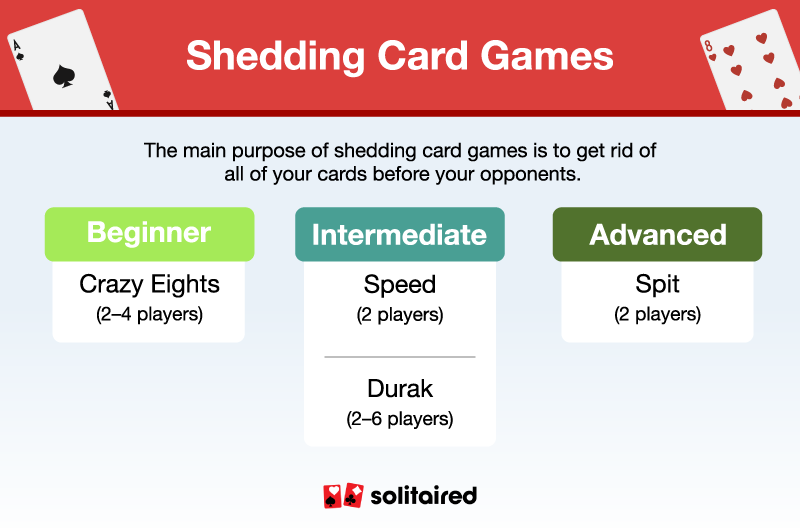
47. Crazy Eights
Number of players: 2–4
Deck: A standard 52-card deck
Objective: Get rid of all your cards first and score the least amount of points to win.
Each player is given five cards, with the top card from the draw pile flipped face up and placed next to the draw pile, creating a discard pile. On your turn, you play a card on the pile that matches that card’s suit or rank. If you can’t play, you must draw three cards. However, playing an eight of anything changes the suit.
48. Speed
Number of players: 2
Deck: A standard 52-card deck
Objective: Be the first to get rid of all the cards in your hand by playing cards that are one rank above or below the cards’ values in the piles.
With all players playing cards simultaneously, place cards from your hand onto face-up piles, but the cards must be one rank higher or lower than the card on the face-up pile. If you can’t play the card in your hand, you use the facedown cards. Every time a card is played, you take one from the draw pile to keep five cards in your hand. Whoever finishes first yells “Speed!” and becomes the winner.
49. Durak
Number of players: 2–6
Deck: A standard 52-card deck with only aces down to sixes
Objective: Avoid being the last player left with cards or known as the fool or “Durak.”
The first attacker is the one with the lowest trump card. Defenders must beat the attacking cards with higher ranked cards of the same suit or trump cards. If they can’t defend, the defender takes the cards in the middle and loses their turn to attack. The point of the game is to shed cards by beating opponents with higher cards and avoid being the last person with cards.
50. Spit
Number of players: 2
Deck: A standard 52-card deck
Objective: The goal is to eliminate the cards before your opponent.
The deck is dealt until no cards are left. Each player then creates five, facedown, stockpiles with the first pile containing one card, the second pile two cards, and so on with the top card of the stockpile flipped face up. The remaining cards are called “spit” cards and are placed in front of the player. Both players play simultaneously onto the two face-up cards in the center by using one hand only and their five stockpiles to play cards one rank higher or lower onto either spit pile. If you can’t move, say, “Spit,” and flip a new card onto your spit pile.
Choose Your Next Card Game!
As you can see, it doesn’t take more than a deck of cards or two to play a wide variety of different card games with your friends and family. In fact, you can still play several games even without the cards. You can play Solitaire and other variants of the game as well as trick-taking games on Solitaired for free. With no email log-in and no paid subscription required, you can just focus on having fun learning how to play the best card games that sharpen your strategy and focus.
About the author

